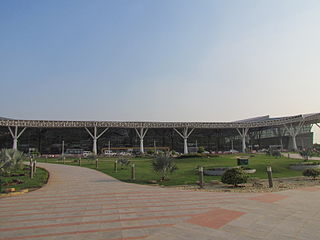
Raipur district is a district in the Chhattisgarh state of India. Its administrative headquarters is the city of Raipur. The district is rich in mineral resources and there are many wildlife sanctuaries. With a population of 2 million, it is the most populous district of Chhattisgarh.
Bargarh is an emerging city and municipality in Bargarh district in the state of odisha in India. It is the administrative headquarters of Bargarh District. Bargarh is popularly known for intensive cultivation of 'paddy', therefore called "Bhata Handi" of Odisha.Also the dhanuyatra of Bargarh is world famous and is known as the "world's largest open theatre".
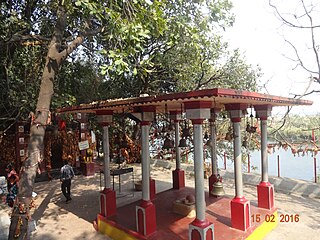
Sambalpur District is a district in the western part of state of Odisha, India. The historic city of Sambalpur is the district headquarters.
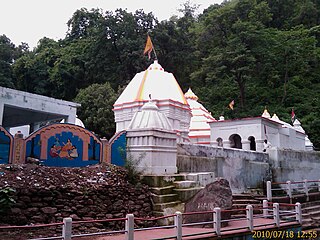
Balangir District, also called Bolangir District, is a district situated in Odisha state of India. The district has an area of 6,575 km2 (2,539 sq mi), and a population of 1,648,997. The town of Balangir is the district headquarters. The composition of the land is predominantly rural. Other important big & small towns in Balangir district are Titlagarh, Patnagarh, Kantabanji, Loisingha, Saintala, Belpada, Tushra, Agalpur, Deogaon, Chudapali, Biripali, Bhalumunda, Bangomunda, Sindhekela,Kansil, Turekela and Muribahal.

Nuapada district is an area of Odisha state in India. Nuapada town is the headquarters of the district. It has one subdivision: Nuapada, and five blocks: Khariar, Sinapali, Boden, Komna, and Nuapada. Nuapada District has three Notified Area Councils: Khariar, Khariar Road, and Nuapada, six tehsils and more villages such as Gandabahali, Tukla, Hatibandha, Duajher, Bargaon, Tarbod, Udyanbandh, and Larka.

Rajnandgaon is a district of the state of Chhattisgarh in central India. The administrative headquarters the district is Rajnandgaon town.

Dakshina Kosala is a historical region of central India. It was located in what is now Madhya Pradesh and Chhattisgarh along with parts of Western Odisha. At its greatest extent, it may have also included a part of the Vidarbha region in present-day Maharashtra.

Boudh District is an administrative and a municipal district, one of the thirty in the Odisha, India. The district headquarters of the Boudh District is the city of Boudh.
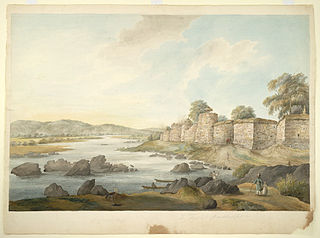
Sambalpur is the fifth largest city in the Indian State of Odisha. It is located on the banks of river Mahanadi, with a population of 335,761. Prehistoric settlements have been recorded there. It is the home of the Sambalpuri sari.

Veer Surendra Sai was a native Indian as well as a regional freedom fighter from Odisha. He fought against the British rule in India after they dethroned the king and queen of Sambalpur State as he was the legal heir. Veer Surendra Sai and his associates Madho Singh, Kunjal Singh, Airi Singh, Bairi Singh, Uddant Sai, Ujjal Sai, Khageswar Dao, Karunakar Singh, Salegram Bariha, Govind Singh, Pahar Singh, Rajee Ghasia, Kamal Singh, Hati Singh, Salik Ram Bariha, Loknath Panda/Gadtia, Mrutunjaya Panigrahi, Jagabandu Hota, Padmanabha Guru, Trilochan Panigrahi, and many others worked together and separately to counter British colonial expansion in India, preventing the British authorities from assuming control over the majority of Western Odisha region for a significant period of time. Many of them were tried and executed by the colonial authorities; Hatte Singh died at the Kalapani Jail in the Andamans. Lion of Sambalpur Veer Surendra Sai died in Asirgarh Jail on 28 February 1884.
Western Odisha is the western part of the state of Odisha in India, extending from the Kalahandi district in the south to the Sundargarh district in the north.

Sambalpur is a district of Odisha. Sambalpur city is the headquarter of Sambalpur district. Sambalpur is the cultural capital of Western Odisha.
Sonepur, is the district headquarters of Subarnapur district of Odisha, has a special place on the political and cultural map of India since the pre-historic period. It is bounded on the north by Sambalpur district, on the south and the South-East by Boudh district, on the east by Rairakhol sub-division of Sambalpur district and on the west by the ex-state Patna.

Sambalpur State, also known as Hirakhand Kingdom was a kingdom founded in 1570. It ruled over Western Odisha and Eastern Chhattisgarh in central-eastern India prior to the Maratha occupation in 1800 AD. From 1849 AD it was integrated with British Raj as a British District. Its capital was present-day Sambalpur city in Western Odisha.

The Kalachuris of Ratnapura were a central Indian dynasty during 11th and 12th centuries. They ruled parts of present-day Chhattisgarh from their capital at Ratnapura. They were an offshoot of the Kalachuris of Tripuri, and ruled as vassals of the parent dynasty for many years.
The Somavamshi or Keshari dynasty ruled parts of present-day Odisha in eastern India between the 9th and the 12th centuries. Their capitals included Yayatinagara and Abhinava-Yayatinagara.
The Panduvamshis or Pandavas were an Indian dynasty that ruled the historical Dakshina Kosala region in present-day Chhattisgarh state of India, during the 7th and the 8th centuries. They may have been related to the earlier Panduvamshis of Mekala: both dynasties claimed lunar lineage and descent from the legendary Pandavas.
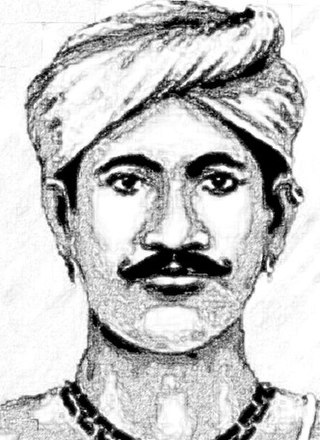
Madhab Singh Bariha or Madho Singh was the Binjhal Zamindar (landlord) of Ghess locality of Bargarh district in Odisha and was a close associate of Veer Surendra Sai in the Sambalpur uprising against the British East India Company. He was hanged to death at the age of 72 on 31 December 1858 at Jail Chowk of Sambalpur, after being caught in the same year for his ferocious and heroic resistance to the British takeover of the region with their appalling policies. Three out of his four valiant sons were martyred while the eldest was sentenced to life imprisonment. His granddaughter Purnima committed suicide after the British hanged her rebellious husband from the Sonakhan Zamindari at Raipur.

The Chindaka Nagas were a dynasty that ruled over parts of modern-day Odisha and Chhattisgarh. Their kingdom was known as Chakrakota mandala and included the present-day districts of Bastar, Koraput and Kalahandi. They were constantly at war with their neighbours- the Somavamshi dynasty, the Kalachuris of Ratnapura, the Mana dynasty and the Western Chalukya Empire.
Trikalinga is a region of central-east India, mentioned in several historical sources. Its identification and its relation to the term "Kalinga" is debated among modern historians, who variously identify it as a distinct region to the west of Kalinga, a larger region comprising Kalinga and two other regions, a constituent of the greater Kalinga, or the three divisions of Kalinga proper.


















